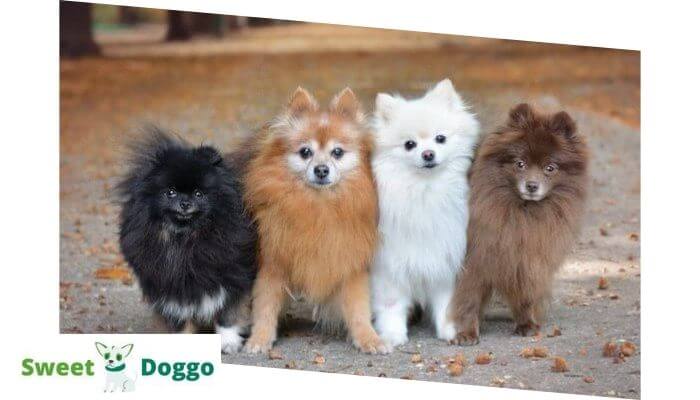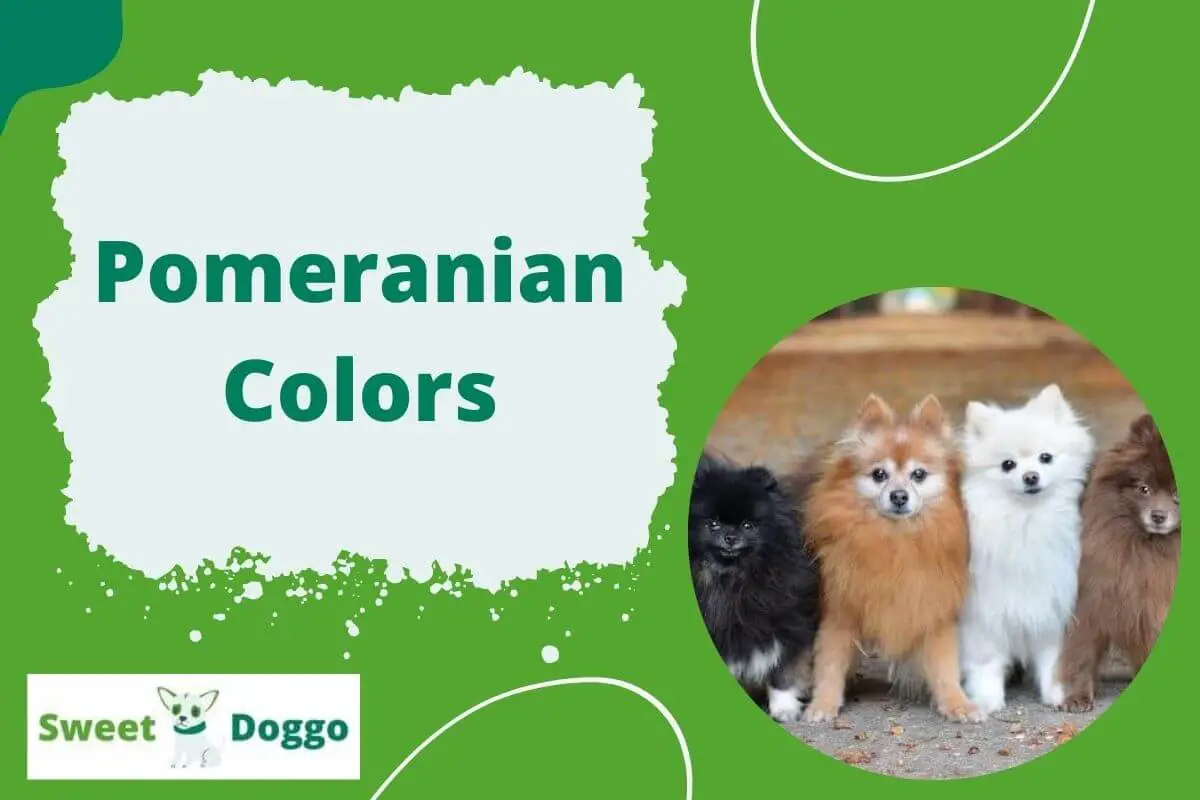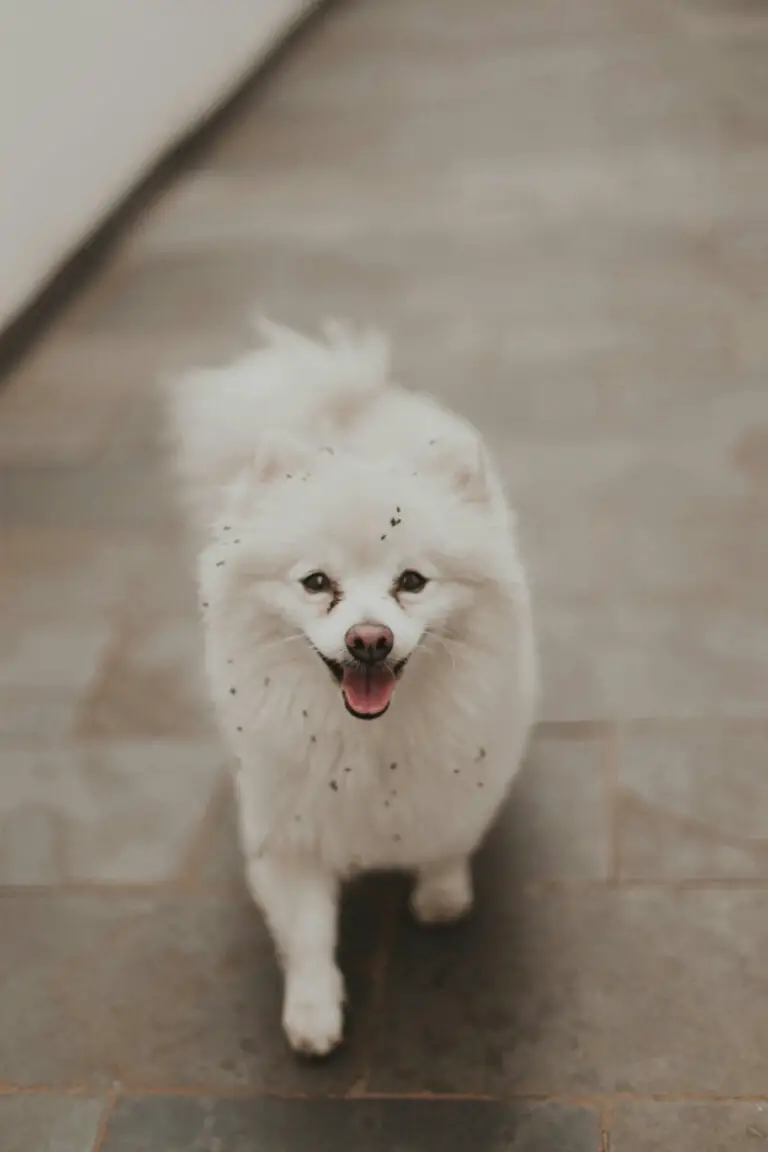Those who are not very familiar with the Pomeranian breed mistakenly believe that these dogs are always orange in color. Although orange is considered the most “classic” shade, the truth is that Pomeranians exhibit a rainbow of color.
From solid and diluted, to partis and marked, the Pomeranian is one of the dogs with the greatest number of possibilities when it comes to appearance.
If you want to become an expert, take a look at the following Pomeranian colors and marking guide, where you can learn to differentiate, for example, orange from a sable-orange.
Table of Contents
Pomeranian Colors
Both the FCI (International Cynological Federation) and the AKC (American Kennel Club) standards establish that the Pomeranian dog can be of any color. Specifically, 5 basic or main colors are mentioned – orange, brown, black, gray-shaded, and white – but the breed admits a wide spectrum of variations and patterns.
Let’s see what Pomeranian colors are and what each of them looks like…
When it comes to identifying the true color of a Pomeranian, experts say it’s best to see the dog in person. Otherwise, it is very easy to get confused by not appreciating the different colors and shades of the coat.
1. Orange Pomeranian
As we mentioned at the beginning, orange is the most popular among all Pomeranian colors. But what some don’t know is that there are many types of orange poms. This is a shade that can range from very light to very dark.
For example, if the orange color is very deep, then it is considered a red Pomeranian (it is actually more rust than red). Other patterns may also occur, such as orange-tabby and sable-orange.
For display purposes, a uniform orange hue in the midrange is most desired. Coat on chest, tail, and legs may exhibit some degree of fading.
Typically, the orange Pomeranian puppy is born with a sable-colored coat, but this slowly begins to lighten and turn orange as the dog grows. When these sable hues do not fade, it is because it is a sable-orange specimen.
2. Black Pomeranian
The true Black Pomeranian Lulu should always have a black undercoat, dark skin, and a shiny black outer coat, without any markings. If there is a secondary color, then it is a parti pomeranian.
It should be noted that some black Poms may have sporadic white hairs, almost always on the chest or between the pads of the paws. This is considered normal.
The skin points, i.e. the nose, lips, eye rims, and paw pads should be a deep solid black.
3. Blue Pomeranian
Blue in the Pomeranian breed is a solid color, not so frequent, but very beautiful and admirable. According to experts, it is the result of diluted black.
These specimens have a blue-gray undercoat and an outer coat that ranges from light to dark gray. Some have a dull blue hue so deep that they give the impression of being black with areas of illumination.
How to know if a Pomeranian is really blue?
The easiest way to tell it apart is to look at its nose. All blue Pomeranians have skin that is a bluish hue; this is what differentiates them from the black specimens. The other points of skin (eye rims, paw pads, lips) will also have a blue tint. Some may have blue eyes.
Note. Sometimes the blue color can only be noticeable under bright sunlight.
In the case of exhibiting any type of additional color, it is likely that it is a tricolor or parti Pomeranian.
4. Pomeranian brown, chocolate, or coffee
In this case, brown is a very diverse color, which can range from a light shade, like a beaver, to darker cinnamon, chocolate, or brown. Most of the time it is a deep, even shade of brown.
As a rule, as long as the skin pigmentation is dark brown, we can say that we are dealing with a chocolate Pomeranian.
Related Article: What are the Types of Pomeranian?
5. Cream Pomeranian
The cream color can also vary quite a bit in Pomeranians. This can be very pale or slightly darker than white, reaching what is almost considered vanilla or light beige. Due to the coarse texture of the hairs on the outer coat, the top of the coat may appear darker.
How do you know if a Pomeranian is a dark cream, rather than cinnamon or light chocolate? Once again, just pay attention to the pigmentation of the skin. A cream Pomeranian will have black points, while chocolate will have brown points.
Cream Pomeranian puppies are always white at birth. Their fur darkens as they mature.
6. Red Pomeranian
This popular little dog can also be red. It’s not actually red, but rather a rusty orange hue. It is the darkest and deepest orange that we can see in the coat of a Pomeranian. It is not such a common color, and in fact, it can sometimes be difficult to identify it.
The red Pomeranian should always have black fur points.
7. Pomeranian sable
A sable Pomeranian should have at least 3 shades of color throughout its coat. Typically, the dog exhibits a solid base tone over which areas of grayish shading or smutting formed by dark spiky hairs are discernible. These hues should be as consistent as possible, with no areas of clean color.
As we will see below, there are different types of sable Pomeranians.
8. Red-sable Pomeranian
Sable-red Pomeranians have a coat with red undertones and dark-tipped areas.
9. Orange-sable Pomeranian
Sable orange is one of the most popular Pomeranian colors. The dog exhibits a deep orange outer coat with black tips, as well as a cream or light orange undercoat. These specimens are usually very dark at birth.
10. Cream-sable Pomeranian
When born, sable-cream puppies have a silvery sooty appearance. This then transitions to a cream shade with some degree of sable on the outer layer.
A cream-sable Pomeranian will always have black whiskers and fur points.
11. Pomeranian wolf-sable or gray-wolf
For many Pomeranian admirers, wolf-sable, wolf-sable, or wolf-gray is a stunning color. These specimens have a light gray undercoat and a darker outer coat with steel-grey hairs and black tips.
There should be no orange or cream tinge over the gray base color.
The wolf-sable Pomeranian has black rims around the eyes, nose, lips, and paw pads.
12. Chocolate-sable Pomeranian
Chocolate-sable Pomeranians exhibit a brown undercoat and a heavier outer coat with dark spiky hairs.
13. Blue-sable Pomeranian
Similar to other sable Pomeranians, blue-coated Pomeranians, whose outer coat appears darker towards the tips of the hairs, are considered sable-blue Pomeranians.
14. Lavender Pomeranian
Lavender or lilac is popularly considered one of the most exotic colors in the Pomeranian breed. It is gray with purple, chocolate, and pink undertones. Without a doubt, it is a rather rare color. In fact, it is not usually accepted in show rings.
Lavender Poms are said to be obtained by breeding two dilute colored dogs such as Blue and Beaver. As in any other case, lavender can also be solid or tricolor.
15. Beaver
Beaver is a very interesting Pomeranian color. It is a diluted brown, which can range from orange-brown to beige cream. The quintessential Beaver Pomeranian will exhibit a deep taupe color and a silvery-blue tint to the tips of the coat.
A very distinctive feature is the pigment in the skin spots. The nose, eye rims, lips, and paw pads are light brown (lighter than the Chocolate Pomeranian). His eyes are hazel.
If the dog has black spots on its skin, its eyes are dark, or there is black in its coat, then it cannot be considered a beaver or chocolate Pomeranian.
16. White Pomeranian
Did you know that this beloved toy-sized dog can also be white? A true white Pomeranian should display a pristine snow-colored coat with no spots or shadows on the coat. Otherwise, the dog should be considered a cream. And in the case of having a secondary color, then it would be considered a tricolor Pomeranian.
Note. Some parti Pomeranians are solid white at birth. The secondary color may develop as the puppy grows.
The white Pomeranian may have pink fur points at birth, but over time these should darken to black. That is an easy way to differentiate it from the albino Pomeranian.
Color Patterns in the Pomeranian Breed

17. Tan/Tan Color Points
The pattern of tan points on the coat occurs in three basic colors: black, brown, and blue. That said, there are the black-tan Pomeranian, the brown-tan Pomeranian, and the blue-tan Pomeranian.
All three colors share the same tan marking pattern. This pattern appears as well-defined rust-colored spots above each eye, on the snout, throat, chest, lower legs/paws, and under the tail.
The marks should be easily visible, and the richer the tan color, the better.
18. Brindle or Brindle
The brindle Pomeranian will have a pattern of dark stripes over a base color, which can be red, gold, or orange. Stripes can be thin or thick. In some Poms, this “striping” will only be apparent on the back.
Another trait to consider is that tabbies often have an extremely dark dorsal stripe.
Brindle can also appear in combination with other patterns in the coat, for example, on a black-tan Pomeranian or a parti Pomeranian.
19. Merle
The merle is a peculiar pattern, not only in Pomeranians but also in many other breeds. This can be produced in almost any base color, hence there are blue-merle, red-merle, white-merle, and chocolate-merle Pomeranians.
If the dog has part of the coat solid color and part of the merle pattern, then it is called a parti-merle Pomeranian. Likewise, it can be the case of a Pomeranian with a blue-merle and tan coat, that is, with tan markings.
Regardless of whether the Pom has merle all over its coat or just part of it, the coat in question will have a dappled appearance.
Another important element is the color of the eyes and skin. The merle gene affects the dark pigment in the eyes, causing these specimens to have light blue, dark blue, or light-medium brown eyes with indigo flecks.
The skin on the nose and paw pads is often mottled with pink and black.
20. Parti-color
Any Pomeranian that has more than a small white spot is usually designated a parti. The term “parti” refers to the presence of two colors in the coat, one of them being white (preferable by the breed standard).
Partis Pomeranians are very popular, as each dog is unique, exhibiting quite a remarkable pattern.
It is known that some clubs and organizations value certain parties more. For example, those who have:
- Whitecoat with only 1 secondary color.
- Uniform white color, without stains or splashes in another tone.
- Symmetrical patches (example: white Pomeranian with a black patch on each leg).
- Symmetrical area of white hair across the head.
- Patches that match the fur points (example: a Parti Pomeranian with blue or sable-blue patches should have matching blue points; one with brown or beaver patches should have brown points; one with other color patches should have had black dots).
- The genes that create a parti can skip several generations. But, in the case of breeding two partis Pomeranians, the result will always be parti puppies.
In general, 3 basic types of parti Pomeranian patterns are recognized: piebald, extreme piebald, and Irish parti.
21. Piebald
The Piebald Pomeranian is white with well-defined markings of another color on the head, body, and base of the tail.
22. Extreme parti
This type of Pomeranian will have very few spots, with 80% or more of its fur being white. Sparse spots usually appear on the head and base of the tail.
23. Irish parti Pomeranian
A Parti-Irish patterned Pomeranian will exhibit white on the neck, chest, belly, paws, tip of the tail, and a sort of blaze or mask on the face.




